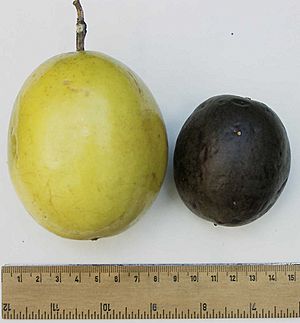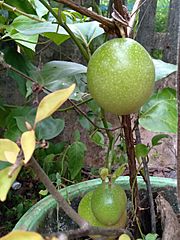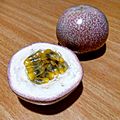Passion fruit facts for kids
Quick facts for kids Passion fruit |
|
|---|---|
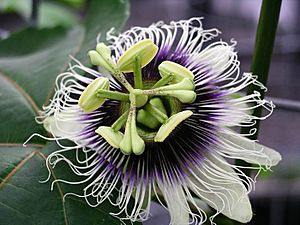 |
|
| Flower | |
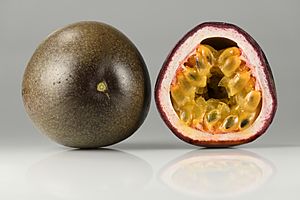 |
|
| Fruit | |
| Scientific classification | |
| Genus: |
Passiflora
|
| Species: |
edulis
|
Passiflora edulis, often called passion fruit, is a type of vine that grows in warm places like southern Brazil, Paraguay, and northern Argentina. People grow it all over the world in tropical and subtropical areas because of its sweet fruit.
The fruit is a type of berry, usually round or oval. It can be yellow or dark purple when it's ripe. Inside, it's soft and juicy, full of small seeds. People eat the fruit fresh or make juice from it. The juice is often added to other fruit juices to make them taste even better!
Contents
What's in a Name?
The name "passion fruit" comes from the "passion flower," which is what the plant's Latin name, Passiflora, means. Around the year 1700, missionaries in Brazil gave it this name. They used the flower to teach local people about Christianity. They called it "flower of the five wounds" because parts of the flower reminded them of the crucifixion of Christ.
About the Plant
The passion fruit plant is a perennial vine, meaning it lives for many years. It has special curly parts called tendrils that help it climb. These tendrils are often red or purple when they are young.
There are two main kinds of passion fruit:
- The purple-fruited type, called P. edulis f. edulis.
- The yellow-fruited type, called P. edulis f. flavicarpa.
The plant usually grows one flower at each node (where a leaf or branch grows). The flowers are about 5–7.5 cm wide. They have green sepals and white petals. The center of the flower is a rich purple, with five stamens (the male parts) and an ovary (the female part) that has a branched style.
The fruit itself is a berry. It can be round or oval. The outside color can be dark purple with small white spots or light yellow. Purple fruits are smaller, weighing about 35 grams, while yellow fruits are larger, around 80 grams. The skin is smooth and tough, about 9–13 mm thick. Inside, there are usually about 250 black seeds. Each seed is covered in a juicy pulp. The juice tastes a bit sour and musky, similar to a guava.
Different Kinds of Passion Fruit
You can find different types of passion fruit that look quite distinct.
- The bright yellow flavicarpa variety is also known as yellow or golden passionfruit. It can grow as big as a grapefruit. Its skin is smooth and light.
- The dark purple edulis variety is smaller, about the size of a lemon. It's less sour than the yellow kind and has a stronger smell and taste.
How People Use Passion Fruit
Passion fruit is loved for its unique taste and is used in many ways around the world, both as a whole fruit and as juice.
- In Australia and New Zealand, you can buy it fresh or in cans. People add it to fruit salads or use the pulp as a topping for desserts like pavlova (a meringue cake) and ice cream. It's also used in cheesecake and in the icing of vanilla slices. There's even a passion fruit soft drink called Passiona made in Australia since the 1920s. It can also be used in some alcoholic drinks.
- In Brazil, passion fruit (called maracujá azedo) is very popular. Passion fruit mousse is a common dessert, and the pulp is used to decorate cakes. Passion fruit juice, ice pops, and soft drinks are also popular. Sometimes, it's used instead of lime in a drink called caipirinha.
- In Cambodia, red and yellow passion fruit from the Mondulkiri Province are used to make wine and liquor.
- In Colombia, it's one of the most important fruits, especially for juices and desserts. You can find three kinds of "maracuyá" fruit there.
- In the Dominican Republic, where it's called chinola, it's used for juice and fruit preserves. Passion fruit syrup is put on shaved ice, and people also eat the raw fruit with sugar.
- In East Africa, passion fruit is used to make fruit juice and is often eaten whole.
- In Hawaii, it's known as liliko'i. People cut it in half and scoop out the seeds with a spoon. Liliko'i-flavored syrup is a popular topping for shave ice. It's also used to flavor malasadas, cheesecakes, cookies, ice cream, and mochi. Passion fruit is also made into jam, jelly, or butter. Liliko'i syrup can even be used to glaze or marinate meat and vegetables.
- In India, the government in Andhra Pradesh started growing passion fruit vines to make the fruit available locally. People eat it raw with sugar or make juice from it.
- In Indonesia, called markisa, there are two types: white flesh and yellow flesh. The white one is usually eaten fresh, while the yellow one is often strained for its juice, which is then cooked with sugar to make a thick syrup.
- In Mexico, passion fruit is used to make juice or eaten raw with chili powder and lime.
- In Paraguay, passion fruit is mainly used for its juice, to make desserts like mousse, cheesecake, and ice cream, and to flavor yogurts and cocktails.
- In Peru, passion fruit has been a key ingredient in homemade ice pops called "marciano" or "chupetes" for a long time. It's also used in many desserts, especially mousses and cheesecakes. Passion fruit juice is drunk on its own and used in ceviche and cocktails, like the Maracuyá sour.
- In the Philippines, passion fruit is commonly sold in markets and schools. Some sellers even give you a straw to suck out the juice and seeds.
- In Portugal, especially the Azores and Madeira, passion fruit is used to make different liqueurs and mousses.
- In Puerto Rico, where it's called "parcha", it's used in juices, ice cream, or pastries.
- In South Africa, passion fruit, known as Granadilla, is used to flavor yogurt and soft drinks. It's often eaten raw or used as a topping for cakes. Granadilla juice is common in restaurants. The yellow type is used for juice, while the purple type is sold fresh.
- In Sri Lanka, passion fruit juice is one of the most popular refreshments. Passion fruit cordial is made by mixing the pulp with sugar.
Nutrition Facts
| Nutritional value per 100 g (3.5 oz) | |
|---|---|
| Energy | 406 kJ (97 kcal) |
|
22.4 g
|
|
| Sugars | 11.2 g |
| Dietary fiber | 10.4 g |
|
0.7 g
|
|
|
Protein
|
2.2 g
|
| Vitamins | Quantity
%DV†
|
| Vitamin A equiv.
beta-Carotene
|
8%
64 μg
7%
743 μg |
| Riboflavin (B2) |
11%
0.13 mg |
| Niacin (B3) |
9%
1.5 mg |
| Vitamin B6 |
8%
0.1 mg |
| Folate (B9) |
4%
14 μg |
| Choline |
2%
7.6 mg |
| Vitamin C |
36%
30 mg |
| Vitamin K |
1%
0.7 μg |
| Minerals | Quantity
%DV†
|
| Calcium |
1%
12 mg |
| Iron |
12%
1.6 mg |
| Magnesium |
8%
29 mg |
| Phosphorus |
10%
68 mg |
| Potassium |
12%
348 mg |
| Sodium |
2%
28 mg |
| Zinc |
1%
0.1 mg |
| Other constituents | Quantity |
| Water | 72.9 g |
|
Full Link to USDA Database entry
|
|
| †Percentages estimated using US recommendations for adults. | |
Raw passion fruit is mostly water (73%). It has carbohydrates (22%), protein (2%), and a little fat (0.7%).
A single passion fruit (about 50 grams) gives you a good amount of vitamin C (18% of what you need daily) and dietary fiber (21%). It also has some B vitamins like riboflavin and niacin, plus iron and phosphorus.
Some types of yellow passion fruit have special compounds in their peel and juice.
Growing Passion Fruit
Passion fruit grows well in warm, tropical and semitropical parts of the world. In the United States, it's grown in Florida, Hawaii, and California. These plants usually need to be kept safe from frost, though some types can survive a light frost if the affected parts are trimmed.
Pollination
For the yellow passion fruit, the flowers need pollen from a different plant to make fruit (they are "self-sterile"). The purple passion fruit can pollinate itself ("self-compatible"). In California, Pollination works best when done by carpenter bees. You can help attract these bees by placing old logs near the vines, as bees like to live in them.
In Culture
The passion fruit flower is the national flower of Paraguay. Also, the hip-hop artist Drake released a popular song called "Passionfruit" in 2017.
Images for kids
See also
 In Spanish: Pasionaria para niños
In Spanish: Pasionaria para niños


